The Drive towards Optimization of Road Lighting Energy Consumption Based on Mesopic Vision—A Suburban Street Case Study
Abstract
:1. Introduction
2. Materials and Methods
3. Results
4. Discussion
5. Conclusions
Author Contributions
Funding
Institutional Review Board Statement
Informed Consent Statement
Data Availability Statement
Acknowledgments
Conflicts of Interest
References
- Li, Y.; Bhagavathula, R.; Terry, T.; Gibbons, R.; Medina, A. Safety Benefits and Best Practices for Intersection Lighting; Virginia Transportation Research Council: Charlottesville, VA, USA, 2020. [Google Scholar]
- Cottrell, B.H. Safety Benefits and Best Practices for Intersection Lighting. Project No. 114315USA. 2020. Available online: http://vtrc.virginiadot.org/ProjDetails.aspx?Id=656 (accessed on 22 February 2021).
- Bozorg, S.; Tetri, E.; Kosonen, I.; Luttinen, T. The Effect of Dimmed Road Lighting and Car Headlights on Visibility in Varying Road Surface Conditions. LEUKOS 2018, 14, 259–273. [Google Scholar] [CrossRef] [Green Version]
- Luckiesh, M. Artificial Light: Its Influence Upon Civilization; The Century Co.: New York, NY, USA, 1920. [Google Scholar]
- Bouroussis, C.A.; Doulos, L.T.; Madias, E.-N.D.; Topalis, F.V. Benchmark test on LED replacements of directional halogen lamps. In Proceedings of the Lux Europa 2013, Krakow, Poland, 17–19 September 2013; pp. 1–6. [Google Scholar]
- Czyzewski, D. LED substitutes of conventional incandescent lamps. Prz. Elektrotechniczny 2012, 88, 123–127. [Google Scholar]
- Fryc, I.; Fryc, J.; Jakubowski, P.; Wąsowski, K.A. Technical, medical and legal aspects of domestic light sources photobiological safety. Prz. Elektrotechniczny 2017, 93, 232–237. [Google Scholar] [CrossRef]
- Kowalska, J. Coloured light pollution in the urban environment. Photon- Lett. Pol. 2019, 11, 93–95. [Google Scholar] [CrossRef]
- Khanh, T.Q. Lighting Quality for Automotive Lighting. Light Eng. 2014, 22, 59–63. [Google Scholar]
- Adragna, C.; Pastori, E. High-efficiency multiple LED-string driver for street lighting and TV backlighting applications. In Proceedings of the 2014 AEIT Annual Conference—From Research to Industry: The Need for a More Effective Technology Transfer, AEIT 2014, Trieste, Italy, 18–19 September 2014; Institute of Electrical and Electronics Engineers: Piscataway, NJ, USA, 2015; pp. 1–6. [Google Scholar]
- Fryc, J.; Fryc, I. Light-emitting diodes in dermatology: Stimulation of wound healing. Dermatol. Rev. 2016, 2, 169–175. [Google Scholar] [CrossRef] [Green Version]
- Ibrahim, M.S.; Fan, J.; Yung, W.K.C.; Prisacaru, A.; van Driel, W.; Fan, X.; Zhang, G. Machine Learning and Digital Twin Driven Diagnostics and Prognostics of Light-Emitting Diodes. Laser Photonics Rev. 2020, 14, 1–33. [Google Scholar] [CrossRef]
- Fryc, I.; Prorok, M. White LED performance analyzed under their different working conditions. Prz. Elektrotechniczny 2013, 89, 274–276. [Google Scholar]
- Fan, J.; Yung, K.-C.; Pecht, M. Lifetime Estimation of High-Power White LED Using Degradation-Data-Driven Method. IEEE Trans. Device Mater. Reliab. 2012, 12, 470–477. [Google Scholar] [CrossRef]
- Czech, E.; Fryc, I. Power control method of color LEDs based luminaries, emitting constant light output, independent from the conditions of its operating environment. Prz. Elektrotechniczny 2014, 90, 270–272. [Google Scholar]
- Penning, J.; Stober, K.; Taylor, V.; Yamada, M. Energy Savings Forecast of Solid-State Lighting in General Illumination Applications; Technical Report; U.S. Department of Energy: Washington, DC, USA, 2014.
- European Union. EC Commission Regulation (EC) No 245/2009 of 18 March 2009 Implementing Directive 2005/32/EC of the European Parliament and of the Council with Regard to Ecodesign Requirements for Fluorescent Lamps Without Integrated Ballast, for High Intensity Discharge Lamps and for Ballasts and Luminaires Able to Operate Such Lamps; European Union: Bruxelles, Belgium, 2009. [Google Scholar]
- European Union. EC Commission Regulation (EC) No 357/2010; of 23 April 2010 amending Regulation (EU) No 185/2010 of 4 March 2010 Laying Down Detailed Measures for The Implementation of The Common Basic Standards on Aviation Security; European Union: Bruxelles, Belgium, 2010. [Google Scholar]
- The European Parliament and the Council Directive 2011/65/Eu of the European Parliament and of the Council of 8 June 2011 on the restriction of the use of certain hazardous substances in electrical and electronic equipment. Off. J. Eur. Union 2011, 1123. [CrossRef]
- BOX, P.C. Relationship between illumination and freeway accidents. J. Illum. Eng. Soc. 1971, 66, 365–393. [Google Scholar]
- Elvik, R. Meta-analysis of evaluations of public lighting as accident countermeasure. Transp. Res. Rec. 1995, 1485, 112–123. [Google Scholar]
- Jackett, M.; Frith, W. Quantifying the impact of road lighting on road safety—A New Zealand Study. IATSS Res. 2013, 36, 139–145. [Google Scholar] [CrossRef] [Green Version]
- Boyce, P.; Eklund, N.; Hamilton, B.; Bruno, L. Perceptions of safety at night in different lighting conditions. Light. Res. Technol. 2000, 32, 79–91. [Google Scholar] [CrossRef]
- Heraty, M.J. Review of Pedestrian Safety Research; Transport and Road Research Laboratory (TRRL): Crowthorne, UK, 1986. [Google Scholar]
- Raynham, P. An examination of the fundamentals of road lighting for pedestrians and drivers. Light. Res. Technol. 2004, 36, 307–313. [Google Scholar] [CrossRef]
- Peña-García, A.; Hurtado, A.; Aguilar-Luzón, M.C. Considerations about the impact of public lighting on pedestrians’ perception of safety and well-being. Saf. Sci. 2016, 89, 315–318. [Google Scholar] [CrossRef]
- Painter, K. The impact of street lighting on crime, fear, and pedestrian street use. Secur. J. 1994, 5, 116–124. [Google Scholar]
- Mattoni, B.; Burattini, C.; Bisegna, F.; Fotios, S. The pedestrian’s perspective: How do illuminance variations affect reassurance? In Proceedings of the 17th IEEE International Conference on Environment and Electrical Engineering and 2017 IEEE Industrial and Commercial Power Systems Europe, (EEEIC/I and CPS Europe), Milan, Italy, 6–9 June 2017; pp. 1–5. [Google Scholar] [CrossRef]
- Fotios, S.; Castleton, H. Specifying Enough Light to Feel Reassured on Pedestrian Footpaths. LEUKOS 2016, 12, 235–243. [Google Scholar] [CrossRef]
- Wąsowski, K.A.; Fryc, J.; Więcko, A.; Fryc, I. Bicycle lighting regulations determined by the quality of vision as well as the European Union legal requirements. Prz. Elektrotechniczny 2014, 90, 256–259. [Google Scholar] [CrossRef]
- Pracki, P.; Wiśniewski, A.; Czyżewski, D.; Krupiński, R.; Skarżyński, K.; Wesołowski, M.; Czaplicki, A. Strategies influencing energy efficiency of lighting solutions. Bull. Pol. Acad. Sci. Tech. Sci. 2020, 68, 711–719. [Google Scholar]
- European Committee for Standardization. Standard EN-13201: Road Lighting; European Committee for Standardization: Bruxelles, Belgium, 2003. [Google Scholar]
- Lewin, I.; Box, P.; Start, R. An Economic Study of Three Light Sources for Roadway Lighting. LEUKOS 2005, 1, 73–80. [Google Scholar] [CrossRef]
- European Committee for Standardization. Standard EN-13201: Road Ligting; European Committee for Standardization: Bruxelles, Belgium, 2015. [Google Scholar]
- Viorel, R.A.; Lucache, D.D.; Livint, G.; Gǎlǎţanu, C.D. Study on Illuminance Class Selection in Street Lighting Design. In Proceedings of the 8th International Conference on Modern Power Systems, MPS 2019, Cluj Napoca, Romania, 21–23 May 2019; pp. 1–6. [Google Scholar]
- Sędziwy, A.; Kotulski, L.; Basiura, A. Enhancing energy efficiency of adaptive lighting control. In Intelligent Information and Database Systems, Proceedings of the 9th Asian Conference ACIIDS 2017, Kazanawa, Japan, 3–5 April 2017; Springer: Cham, Switzerland, 2017; pp. 487–496. [Google Scholar]
- De Boer, J.B.; Burghout, F.; Van Heemskerck Veeckens, J.F.T. Appraisal of the quality of public lighting based on road surface luminance and glare. In Proceedings of the 14th Session of CIE, Brussels, Belgium, 2 October 1959. [Google Scholar]
- De Grijs, J.C. Visuele beoordelingen van verlichtingscriteria in Den Haag en Amsterdam (Visual assessments of lighting criteria in The Hague and Amsterdam). Elektrotechniek 1972, 50, 515–521. [Google Scholar]
- Boer, B.J. Quality Aspects in Public Lighting; Philips Engineering Report. 24; Philips: Eindhoven, The Netherlands, 1972. [Google Scholar]
- Economopoulos, I.-G. Photometric Parameters and Visual Performance in Road Lighting. Ph.D. Thesis, Technische Hogeschool Eindhoven, Eindhoven, The Netherlands, October 1978. [Google Scholar] [CrossRef]
- Wojnicki, I.; Ernst, S.; Kotulski, L.; Sedziwy, A. Advanced street lighting control. Expert Syst. Appl. 2014, 41, 999–1005. [Google Scholar] [CrossRef]
- Kusznier, J.; Wojtkowski, W. Spectral properties of smart LED lamps. Photon Lett. Pol. 2020, 12, 16–18. [Google Scholar] [CrossRef]
- Galatanu, C.D. On/Off Optimization of Public Lighting Systems Depending on the Road Class. Procedia Manuf. 2020, 46, 378–383. [Google Scholar] [CrossRef]
- Correa, J.; Ponce, M.; Arau, J.; Alonso, J.M. Dimming in metal-halide and HPS lamps operating at HF: Effects and modeling. In Proceedings of the Conference Record of the 2002 IEEE Industry Applications Society—37th IAS Annual Meeting, Pittsburgh, PA, USA, 13–18 October 2002; pp. 1467–1474. [Google Scholar]
- Li, F.; Chen, Y.; Liu, Y.; Chen, D. Comparative in Situ Study of LEDs and HPS in Road Lighting. LEUKOS 2012, 8, 205–214. [Google Scholar] [CrossRef]
- Jägerbrand, A.K. LED (Light-Emitting Diode) Road Lighting in Practice: An Evaluation of Compliance with Regulations and Improvements for Further Energy Savings. Energies 2016, 9, 357. [Google Scholar] [CrossRef] [Green Version]
- Djuretic, A.; Kostic, M. Actual energy savings when replacing high-pressure sodium with LED luminaires in street lighting. Energy 2018, 157, 367–378. [Google Scholar] [CrossRef]
- Hölker, F.; Moss, T.; Griefahn, B.; Kloas, W.; Voigt, C.C.; Henckel, D.; Hänel, A.; Kappeler, P.M.; Völker, S.; Schwope, A.; et al. The Dark Side of Light: A Transdisciplinary Research Agenda for Light Pollution Policy. Ecol. Soc. 2010, 15, 1–13. [Google Scholar] [CrossRef]
- Viorel, R.A.; Dumitru Lucache, D.; Gǎlǎţanu, C.D. Calculation of Energy Economy by Dimming LED Lamps with Maximum Performance. In Proceedings of the 2019 IEEE International Conference on Environment and Electrical Engineering and 2019 IEEE Industrial and Commercial Power Systems Europe, EEEIC/I and CPS Europe, Genova, Italy, 10–14 June 2019; pp. 1–6. [Google Scholar]
- Donatello, S.; Rodríguez, R.; Caldas Quintero, M.G.; Wolf, O.; Van Tichelen, P.; Van Hoof, V.; Geerken, T. Revision of the EU Green Public Procurement Criteria for Road Lighting and Traffic Signals; Publications Office of the European Union: Luxembourg, 2019; p. 127. [Google Scholar] [CrossRef]
- Fryc, I.; Tabaka, P. The night sky light pollution created by outdoor luminaires. Prz. Elektrotechniczny 2017, 93, 46–49. [Google Scholar] [CrossRef]
- Peña-García, A.; Sędziwy, A. Optimizing Lighting of Rural Roads and Protected Areas with White Light: A Compromise among Light Pollution, Energy Savings, and Visibility. LEUKOS 2020, 16, 147–156. [Google Scholar] [CrossRef]
- Fryc, I.; Bisegna, F.; Tabaka, P. Lighting of recreation grounds as a source of sky glow—The influence of luminaire type on this phenomenon. In Proceedings of the 2017 17th IEEE International Conference on Environment and Electrical Engineering and 2017 1st IEEE Industrial and Commercial Power Systems Europe (EEEIC/I and CPS Europe), Milan, Italy, 6–9 June 2017; pp. 1–4. [Google Scholar] [CrossRef]
- Chodakowski, A.; Fryc, I. Generating light with specified chromaticity coordinates. Prz. Elektrotechniczny 2008, 84, 86–89. [Google Scholar]
- Bergen, A. A practical method of comparing luminous intensity distributions. Light. Res. Technol. 2012, 44, 27–36. [Google Scholar] [CrossRef]
- Sun, C.-C.; Lee, X.-H.; Moreno, I.; Lee, C.-H.; Yu, Y.-W.; Yang, T.-H.; Chung, T.-Y. Design of LED Street Lighting Adapted for Free-Form Roads. IEEE Photon J. 2017, 9, 1–13. [Google Scholar] [CrossRef]
- Zhu, R.; Hong, Q.; Zhang, H.; Wu, S.-T. Freeform reflectors for architectural lighting. Opt. Express 2015, 23, 31828–31837. [Google Scholar] [CrossRef]
- Zalewski, S. Design of optical systems for LED road luminaires. Appl. Opt. 2015, 54, 163–170. [Google Scholar] [CrossRef] [PubMed] [Green Version]
- Czyzewski, D. Selected problems of defining the luminous area of electroluminescent diodes. Prz. Elektrotechniczny 2008, 84, 129–131. [Google Scholar]
- Czyżewski, D. Luminance distribution of LED luminous surface. Prz. Elektrotechniczny 2010, 86, 166–169. [Google Scholar]
- Czyżewski, D. Comparison of luminance distribution on the lighting surface of power LEDs. Photon- Lett. Pol. 2019, 11, 118–120. [Google Scholar] [CrossRef]
- Fryc, I.; Tabaka, P. Outdoor Areas Lighting with LEDs—The Competition Between Scotopic Efficacy and Light Pollution. Photon- Lett. Pol. 2019, 11, 75–77. [Google Scholar] [CrossRef]
- Czyzewski, D. Monitoring of the lighting conditions of a street illuminated with road lights equipped with LEDs. Prz. Elektrotechniczny 2010, 86, 170–172. [Google Scholar]
- Fryc, I. LED’s spectral power distribution under different condition of operating temperature and driving current. Prz. Elektrotechniczny 2010, 86, 187–189. [Google Scholar]
- Czyzewski, D. Monitoring of the first LED lighting installations in Warsaw. Prz. Elektrotechniczny 2011, 87, 13–16. [Google Scholar]
- De Boer, J.B.; Schreuder, D.A. Glare as a Criterion for Quality in Street Lighting. Light. Res. Technol. 1967, 32, 117–135. [Google Scholar] [CrossRef]
- Schreuder, D. Discomfort glare in street lighting. Light. Res. Technol. 1972, 4, 47–48. [Google Scholar] [CrossRef]
- Słomiński, S. Identifying problems with luminaire luminance measurements for discomfort glare analysis. Light. Res. Technol. 2016, 48, 573–588. [Google Scholar] [CrossRef]
- Sun, C.-C.; Jiang, C.-J.; Chen, Y.-C.; Yang, T.-H. Glare effect for three types of street lamps based on White LEDs. Opt. Rev. 2014, 21, 215–219. [Google Scholar] [CrossRef]
- Girard, J.; Villa, C.; Brémond, R. Discomfort Glare from Several Sources: A Formula for Outdoor Lighting. LEUKOS 2019, 1–17. [Google Scholar] [CrossRef]
- Eloholma, M.; Viikari, M.; Halonen, L.; Walkey, H.; Goodman, T.; Alferdinck, J.; Freiding, A.; Bodrogi, P.; Várady, G. Mesopic models—From brightness matching to visual performance in night-time driving: A review. Light. Res. Technol. 2005, 37, 155–175. [Google Scholar] [CrossRef]
- CIE Technical Raport CIE 191: Recommended System for Mesopic Photometry Based on Visual Performance; CIE: Vienna, Austria, 2010.
- Maksimainen, M.; Kurkela, M.; Bhusal, P.; Hyyppä, H. Calculation of Mesopic Luminance Using per Pixel S/P Ratios Measured with Digital Imaging. LEUKOS 2019, 15, 309–317. [Google Scholar] [CrossRef]
- Uchida, T.; Ohno, Y. Simplified field measurement methods for the CIE mesopic photometry system. Light. Res. Technol. 2017, 49, 774–787. [Google Scholar] [CrossRef]
- Goodman, T.; Forbes, A.; Walkey, H.; Eloholma, M.; Halonen, L.; Alferdinck, J.; Freiding, A.; Bodrogi, P.; Várady, G.; Szalmas, A. Mesopic visual efficiency IV: A model with relevance to nighttime driving and other applications. Light. Res. Technol. 2007, 39, 365–392. [Google Scholar] [CrossRef]
- Fotios, S.; Cheal, C. Predicting lamp spectrum effects at mesopic levels. Part 1: Spatial brightness. Light. Res. Technol. 2011, 43, 143–157. [Google Scholar] [CrossRef] [Green Version]
- Lewis, A.L. Visual Performance as a Function of Spectral Power Distribution of Light Sources at Luminances Used for General Outdoor Lighting. J. Illum. Eng. Soc. 1999, 28, 37–42. [Google Scholar] [CrossRef]
- Ylinen, A.-M.; Tähkämö, L.; Puolakka, M.; Halonen, L. Road Lighting Quality, Energy Efficiency, and Mesopic Design—LED Street Lighting Case Study. LEUKOS 2011, 8, 9–24. [Google Scholar] [CrossRef]
- Gibbons, R.; Terry, T.; Bhagavathula, R.; Meyer, J.; Lewis, A. Applicability of mesopic factors to the driving task. Light. Res. Technol. 2015, 48, 70–82. [Google Scholar] [CrossRef]
- Illuminating Engineering Society. IES TM-12-12. Spectral Effects of Lighting on Visual Performance at Mesopic Light Levels; Illuminating Engineering Society: New York, NY, USA, 2012. [Google Scholar]
- Ohashi, R.; Akashi, Y.; Uchida, T. Comparisons between off-axis detection and on-axis recognition to implement mesopic photometry in roadway lighting standards. Light. Res. Technol. 2019, 52, 540–553. [Google Scholar] [CrossRef]
- Fotios, S.; Cheal, C. Lighting for subsidiary streets: Investigation of lamps of different SPD. Part 2—Brightness. Light. Res. Technol. 2007, 39, 233–249. [Google Scholar] [CrossRef]
- White Paper. Methods for Comparing Visual Illumination Between HID and LED Luminaires to Optimize Visual Performance in Low Light Environments. Emerson 2018, 12, 1–12. [Google Scholar]
- Bullough, J.D. Spectral Considerations for Transportation Lighting Systems. In Proceedings of the Frontiers in Optics 2017; Optical Society of America, Washington, DC, USA, 15–19 September 2017; p. FTh3C.4. [Google Scholar]
- Djokic, L.; Cabarkapa, A.; Djuretic, A. Drivers’ impressions under high-pressure sodium and LED street lighting. Light. Res. Technol. 2017, 50, 1212–1224. [Google Scholar] [CrossRef]
- Illuminating Engineering Society. IES TM-24-13. An Optional Method for Adjusting the Recommended Illuminance for Visually Demanding Tasks Within IES Illuminance Categories P through Y Based on Light Source Spectrum; Illuminating Engineering Society: New York, NY, USA, 2013. [Google Scholar]
- Tetri, E.; Chenani, S.B.; Räsänen, R.-S.; Baumgartner, H.; Vaaja, M.; Sierla, S.; Tähkämö, L.; Virtanen, J.-P.; Kurkela, M.; Ikonen, E.; et al. Tutorial: Road Lighting for Efficient and Safe Traffic Environments. LEUKOS 2017, 13, 223–241. [Google Scholar] [CrossRef]
- Czyżewski, D.; Fryc, I. The Influence of Luminaire Photometric Intensity Curve Measurements Quality on Road Lighting Design Parameters. Energies 2020, 13, 3301. [Google Scholar] [CrossRef]
- Bálský, M. Luminance values extraction from digital images. In Proceedings of the 2016 IEEE Lighting Conference of the Visegrad Countries (Lumen V4), Karpacz, Poland, 13–16 September 2016; pp. 1–3. [Google Scholar]
- Galatanu, C.D. Improving the Luminance Measurement from Digital Images. In Proceedings of the 2019 International Conference on Electromechanical and Energy Systems (SIELMEN), Craiova, Romania, 9–11 October 2019; pp. 1–4. [Google Scholar]
- Czyzewski, D. Monitoring of the subsequent LED lighting installation in Warsaw in the years 2014–2015. In Proceedings of the 2016 IEEE Lighting Conference of the Visegrad Countries, (Lumen V4), Karpacz, Poland, 13–16 September 2016; pp. 1–4. [Google Scholar]
- Fryc, I. Accuracy of spectral correction of a CCD array for luminance distribution measurement. In Proceedings of the SPIE 5064 Lightmetry 2002: Metrology and Testing Techniques Using Light, Warsaw, Poland, 14–16 May 2003; Volume 5064, pp. 38–42. [Google Scholar]
- Fryc, I.; Czech, E. Application of optical fibers and CCD array for measurement of luminance distribution. In Proceedings of the SPIE 5064 Lightmetry 2002: Metrology and Testing Techniques Using Light, Warsaw, Poland, 14–16 May 2003; Volume 5064, pp. 18–21. [Google Scholar]
- Czyzewski, D.; Słomiński, S. Digital measurement of road lighting. Prz. Elektrotechniczny 2012, 88, 92–94. [Google Scholar]
- Greffier, F.; Muzet, V.; Boucher, V.; Fournela, F.; Dronneau, R. Use of an imaging luminance measuring device to evaluate road lighting performance at different angles of observation. In Proceedings of the 29th Quadrennial Session of the International Commission on Illumination (CIE), Washington, DC, USA, 14–22 June 2019; pp. 553–562. [Google Scholar]
- Greffier, F.; Charbonnier, P.; Tarel, J.-P.; Boucher, V.; Fournela, F. An automatic system for measuring road and tunnel lighting performance. In Proceedings of the 28th CIE session, Manchester, UK, 28 June–4 July 2015; pp. 1647–1656. [Google Scholar]
- Fiorentin, P.; Iacomussi, P.; Rossi, G. Characterization and Calibration of a CCD Detector for Light Engineering. IEEE Trans. Instrum. Meas. 2005, 54, 171–177. [Google Scholar] [CrossRef]
- Fiorentin, P.; Scroccaro, A. Detector-Based Calibration for Illuminance and Luminance Meters—Experimental Results. IEEE Trans. Instrum. Meas. 2010, 59, 1375–1381. [Google Scholar] [CrossRef]
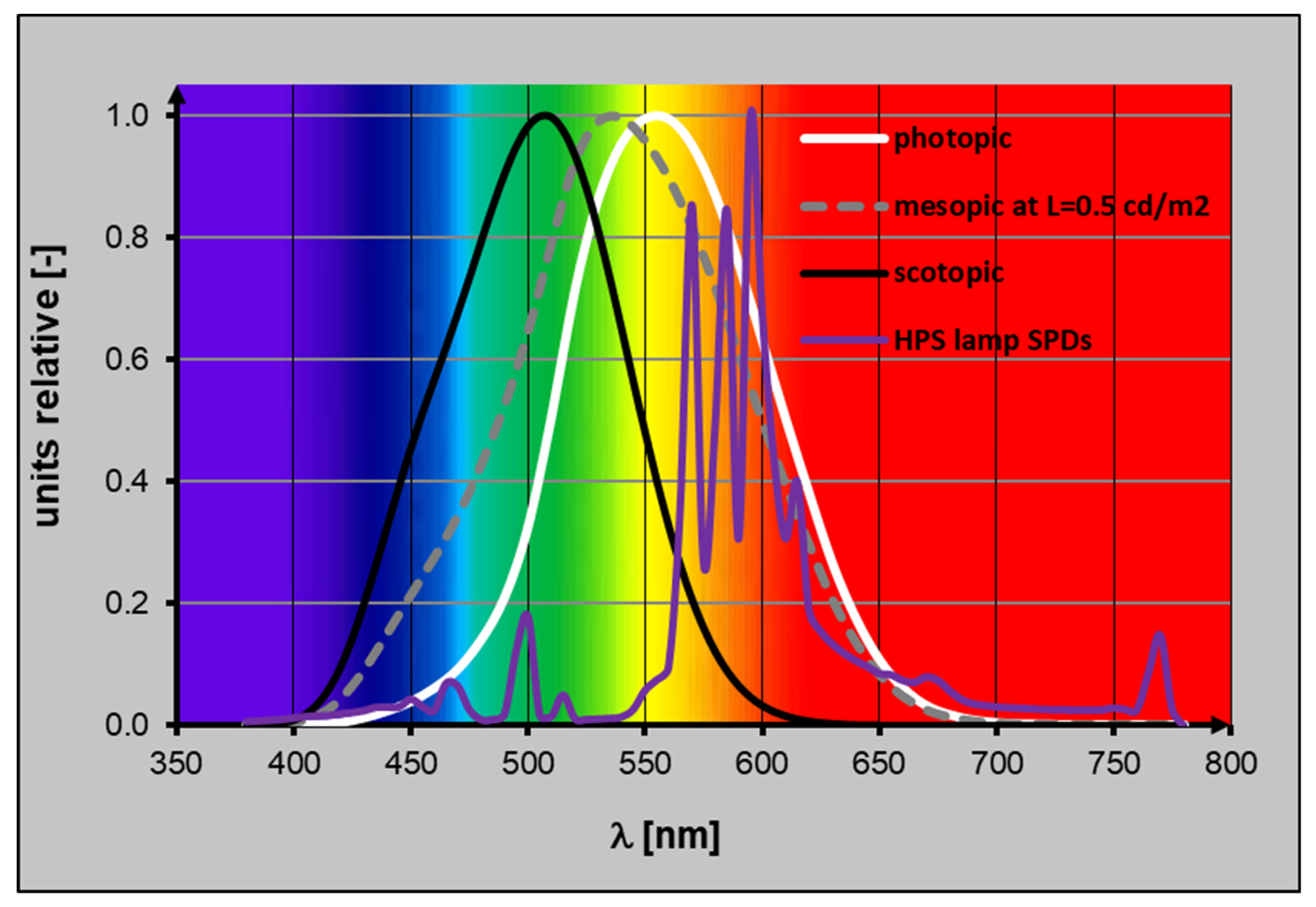
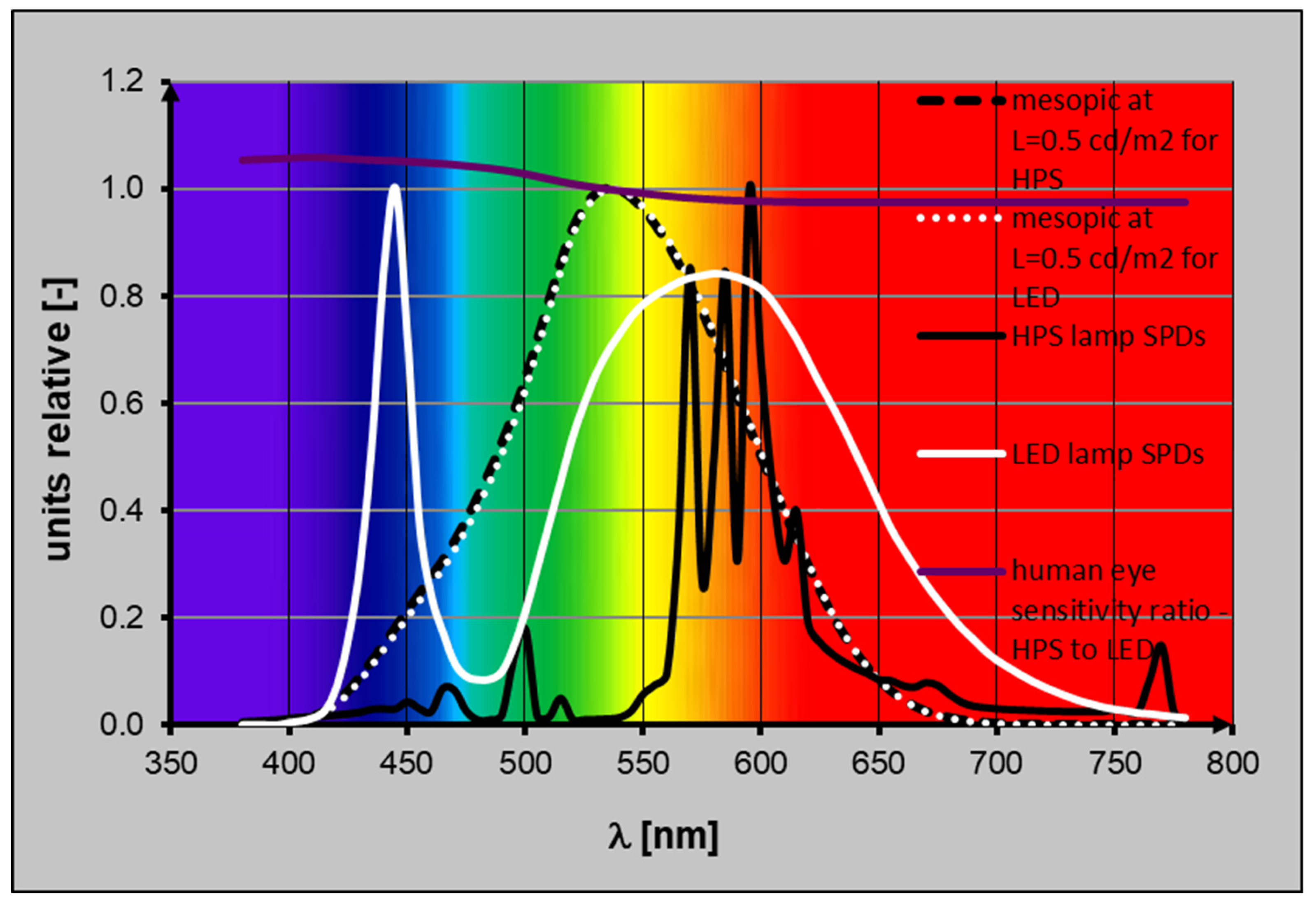

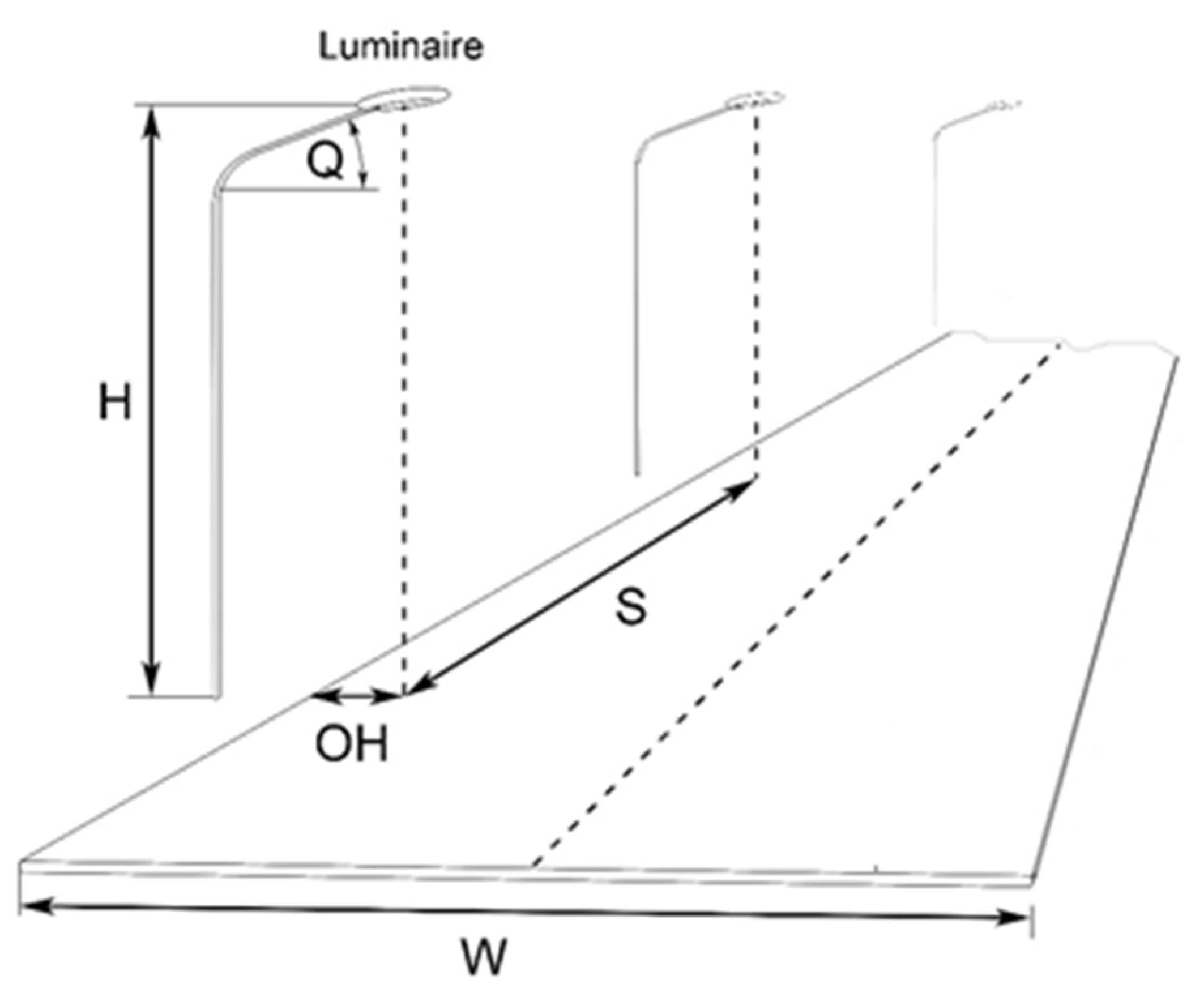

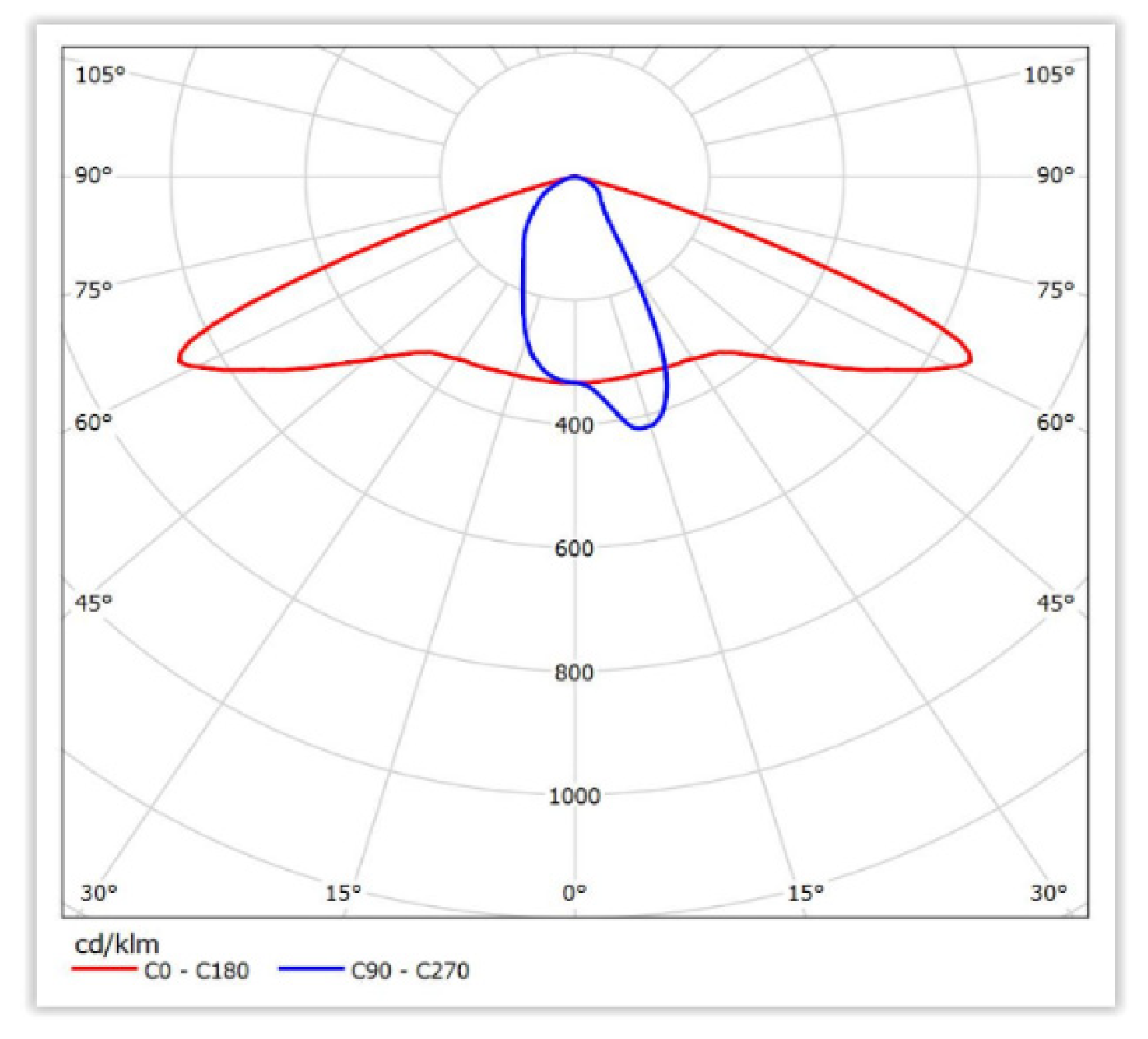



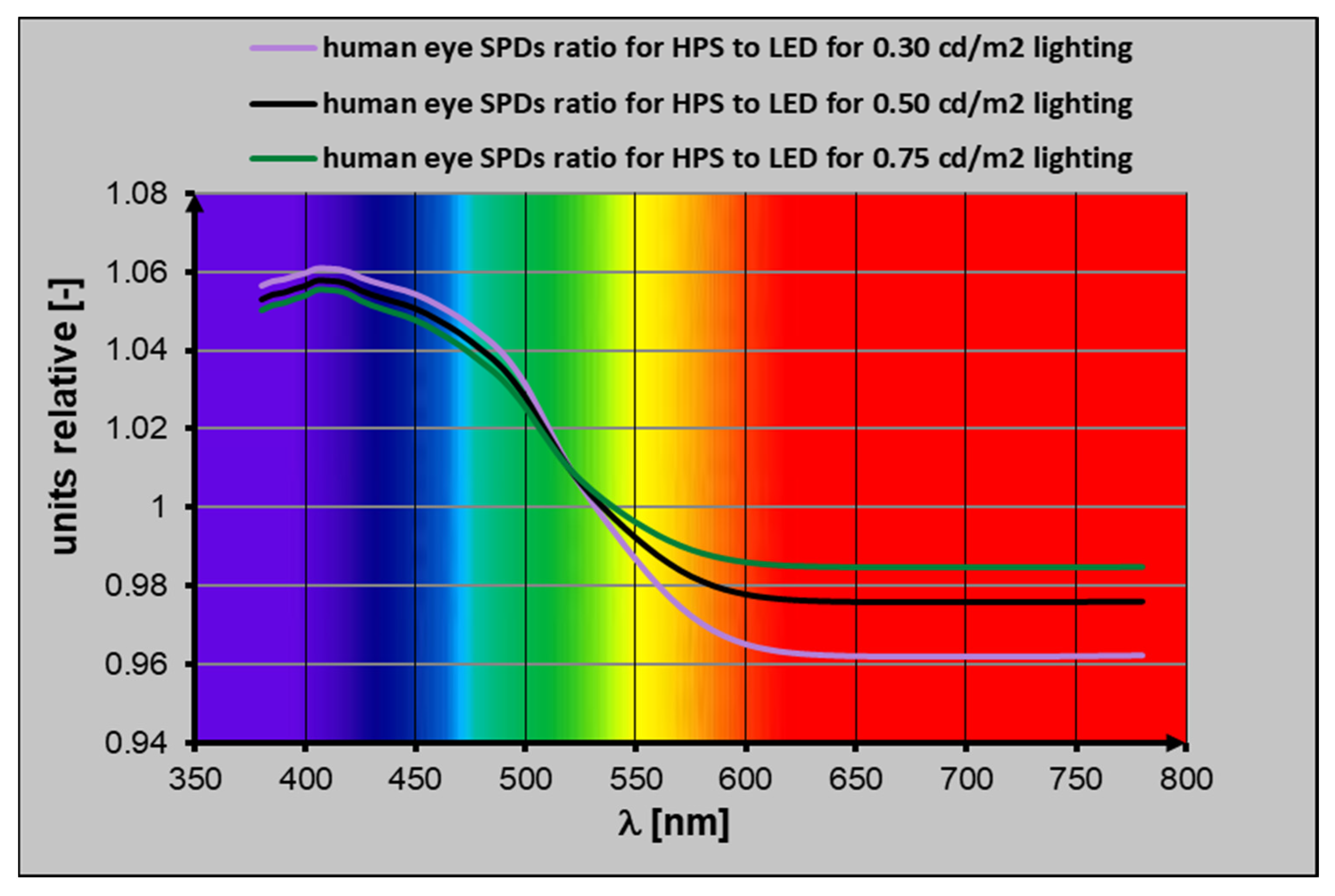












| Lighting Classes | Lav [cd/m2] | Uo [–] | UI [–] | fTI [%] | REI [–] |
|---|---|---|---|---|---|
| M1 | 2.00 | 0.40 | 0.70 | 10 | 0.35 |
| M2 | 1.50 | 0.40 | 0.70 | 10 | 0.35 |
| M3 | 1.00 | 0.40 | 0.60 | 15 | 0.30 |
| M4 | 0.75 | 0.40 | 0.60 | 15 | 0.30 |
| M5 | 0.50 | 0.35 | 0.40 | 15 | 0.30 |
| M6 | 0.30 | 0.35 | 0.40 | 15 | 0.30 |
| Technical Parameter | Luminaire (LED_26W) |
|---|---|
| Light source type | LED |
| Number of light sources | 16 |
| Current LED | 500 mA |
| Luminaire luminous flux | 2900 lm |
| Luminaire power | 26 W |
| Luminaire lighting efficiency | 126 lm/W |
| Luminaire efficiency | 83% |
| Light color | Natural White (CCT 4000 K) |
| Month | Sunrise Hour for the First Day of the Month | Sunset Hour for the First Day of the Month | Sunrise Hour for the Last Day of the Month | Sunset Hour for the Last Day of the Month |
|---|---|---|---|---|
| January | 7:46:00 a.m. | 3:31:00 p.m. | 7:19:00 a.m. | 4:18:00 p.m. |
| February | 7:19:00 a.m. | 4:18:00 p.m. | 6:23:00 a.m. | 5:12:00 p.m. |
| March | 6:20:00 a.m. | 5:14:00 p.m. | 6:11:00 a.m. | 7:07:00 p.m. |
| April | 6:09:00 a.m. | 7:09:00 p.m. | 5:06:00 a.m. | 7:58:00 p.m. |
| May | 5:04:00 a.m. | 8:00:00 p.m. | 4:21:00 a.m. | 8:44:00 p.m. |
| June | 4:21:00 a.m. | 8:45:00 p.m. | 4:20:00 a.m. | 8:58:00 p.m. |
| July | 4:21:00 a.m. | 8:58:00 p.m. | 4:58:00 a.m. | 8:25:00 p.m. |
| August | 4:59:00 a.m. | 8:24:00 p.m. | 5:48:00 a.m. | 7:22:00 p.m. |
| September | 5:50:00 a.m. | 7:20:00 p.m. | 6:37:00 a.m. | 6:12:00 p.m. |
| October | 6:39:00 a.m. | 6:10:00 p.m. | 6:32:00 a.m. | 4:05:00 p.m. |
| November | 6:34:00 a.m. | 4:03:00 p.m. | 7:24:00 a.m. | 3:25:00 p.m. |
| December | 7:25:00 a.m. | 3:24:00 p.m. | 7:46:00 a.m. | 3:31:00 p.m. |
| Hours Range | Lighting Classes |
|---|---|
| 0:00 a.m.–5:00 a.m. | M6 |
| 5:00 a.m.–7:00 a.m. | M5 |
| 7:00 a.m.–9:00 a.m. | M4 |
| 9:00 a.m.–03:00 p.m. | day light—lamps off |
| 03:00 p.m.–05:00 p.m. | M4 |
| 05:00 p.m.–11:00 p.m. | M5 |
| 11:00 p.m.–0:00 a.m. | M6 |
| Lighting Class | Luminance Le [cd/m2] (Photopic Vision —for HPS Lamp) | Luminance Lmes [cd/m2] (Mesopic Vision—for HPS Lamp and for LED Lamp) | Luminance Le [cd/m2] (Photopic Vision—for LED Lamp Providing Lmes Equal to Lmes with HPS Lamp |
|---|---|---|---|
| M4 | 0.75 | 0.71 | 0.68 |
| M5 | 0.50 | 0.47 | 0.43 |
| M6 | 0.30 | 0.27 | 0.25 |
| Hours Range | Luminance [cd/m2] Scenario 1 | Luminance [cd/m2] Scenario 2 | Luminance [cd/m2] Scenario 3 |
|---|---|---|---|
| 0:00 a.m.–5:00 a.m. | 0.30 | 0.25 | 0.75 |
| 5:00 a.m.–7:00 a.m. | 0.50 | 0.43 | 0.75 |
| 7:00 a.m.–9:00 a.m. | 0.75 | 0.68 | 0.75 |
| 9:00 a.m.–3:00 p.m. | lamps off | lamps off | lamps off |
| 3:00 p.m.–5:00 p.m. | 0.75 | 0.68 | 0.75 |
| 5:00 p.m.–11:00 p.m. | 0.50 | 0.43 | 0.75 |
| 11:00 p.m.–0:00 a.m. | 0.30 | 0.25 | 0.75 |
| Control Signal (U) [V] | Luminous Flux (Φ) [lm] | Consumed Power (P) [W] |
|---|---|---|
| 10.0 | 2849.9 | 27.27 |
| 9.5 | 2849.9 | 27.25 |
| 9.0 | 2849.9 | 27.22 |
| 8.5 | 2849.9 | 27.21 |
| 8.0 | 2831.9 | 26.98 |
| 7.5 | 2677.8 | 25.43 |
| 7.0 | 2510.2 | 23.78 |
| 6.5 | 2359.3 | 22.17 |
| 6.0 | 2180.4 | 20.77 |
| 5.5 | 2006.6 | 18.96 |
| 5.0 | 1837.0 | 17.42 |
| 4.5 | 1663.2 | 15.85 |
| 4.0 | 1471.9 | 14.21 |
| 3.5 | 1264.5 | 12.57 |
| 3.0 | 1071.1 | 10.84 |
| 2.5 | 873.2 | 9.25 |
| 2.0 | 680.2 | 7.79 |
| 1.5 | 492.9 | 6.18 |
| 1.0 | 290.5 | 4.57 |
| Average Luminance Level (Le) [cd/m2] | Control Signal (U) [V] | Luminous Flux (Φ) [lm] | Luminous Flux (Φ) [%] | Active Power (P) [W] | Active Power (P) [%] |
|---|---|---|---|---|---|
| 0.75 | 10.00 | 2849.9 | 100 | 27.27 | 100 |
| 0.68 | 7.25 | 2591.3 | 91 | 24.38 | 88 |
| 0.50 | 5.22 | 1907.9 | 67 | 18.13 | 65 |
| 0.43 | 4.42 | 1624.7 | 57 | 15.60 | 56 |
| 0.30 | 3.17 | 1140.8 | 40 | 11.42 | 41 |
| 0.25 | 2.65 | 940.0 | 33 | 9.77 | 35 |
| Hours Range | Scenario 1 (Φ) [%] | Scenario 2 (Φ) [%] | Scenario 3 (Φ) [%] |
|---|---|---|---|
| 0:00 a.m.–5:00 a.m. | 40 | 33 | 100 |
| 5:00 a.m.–7:00 a.m. | 67 | 57 | 100 |
| 7:00 a.m.–7:46 a.m. | 100 | 91 | 100 |
| 7:46 a.m.–3:31 p.m. | lamps off | lamps off | lamps off |
| 3:00 p.m.–5:00 p.m. | 100 | 91 | 100 |
| 5:00 p.m.–11:00 p.m. | 67 | 57 | 100 |
| 11:00 p.m.–0:00 a.m. | 40 | 33 | 100 |
| Month | Energy Consumption (Scenario 1) [kWh] and [%] | Energy Consumption (Scenario 2) [kWh] and [%] | Energy Consumption (Scenario 3) [kWh] and [%] | |||
|---|---|---|---|---|---|---|
| January | 321.13 | 100% | 275.96 | 85.93% | 532.37 | 165.78% |
| February | 250.86 | 100% | 213.47 | 85.10% | 446.10 | 177.83% |
| March | 219.29 | 100% | 185.83 | 84.74% | 409.15 | 186.58% |
| April | 167.53 | 100% | 141.60 | 84.52% | 329.26 | 196.54% |
| May | 135.96 | 100% | 114.62 | 84.30% | 280.21 | 206.10% |
| June | 114.96 | 100% | 96.83 | 84.23% | 241.31 | 209.91% |
| July | 127.32 | 100% | 107.25 | 84.24% | 266.70 | 209.47% |
| August | 160.27 | 100% | 135.33 | 84.44% | 321.05 | 200.32% |
| September | 198.32 | 100% | 167.95 | 84.69% | 375.21 | 189.19% |
| October | 253.54 | 100% | 215.55 | 85.02% | 456.37 | 180.00% |
| November | 298.23 | 100% | 255.80 | 85.77% | 501.45 | 168.14% |
| December | 339.51 | 100% | 292.62 | 56.19% | 550.75 | 162.22% |
| SUM | 2586.92 | (100%) | 2202.81 | (85.15%) | 4709.93 | (182.07%) |
| Control Signal [V] | Luminous Flux (Φ) [%] | Active Power (P) [%] | Average Luminance Value of Road Surface (Le) [cd/m2] | Longitudinal Uniformity (Ul) [–] | Overall Uniformity (Uo) [–] |
|---|---|---|---|---|---|
| 10.0 | 100 | 100 | 0.77 | 0.62 | 0.40 |
| 7.25 | 91 | 88 | 0.68 | 0.61 | 0.41 |
| 5.22 | 67 | 65 | 0.51 | 0.61 | 0.40 |
| 4.42 | 57 | 56 | 0.43 | 0.61 | 0.40 |
| 3.17 | 40 | 41 | 0.31 | 0.62 | 0.41 |
| 2.65 | 33 | 35 | 0.25 | 0.61 | 0.40 |
Publisher’s Note: MDPI stays neutral with regard to jurisdictional claims in published maps and institutional affiliations. |
© 2021 by the authors. Licensee MDPI, Basel, Switzerland. This article is an open access article distributed under the terms and conditions of the Creative Commons Attribution (CC BY) license (http://creativecommons.org/licenses/by/4.0/).
Share and Cite
Fryc, I.; Czyżewski, D.; Fan, J.; Gălăţanu, C.D. The Drive towards Optimization of Road Lighting Energy Consumption Based on Mesopic Vision—A Suburban Street Case Study. Energies 2021, 14, 1175. https://doi.org/10.3390/en14041175
Fryc I, Czyżewski D, Fan J, Gălăţanu CD. The Drive towards Optimization of Road Lighting Energy Consumption Based on Mesopic Vision—A Suburban Street Case Study. Energies. 2021; 14(4):1175. https://doi.org/10.3390/en14041175
Chicago/Turabian StyleFryc, Irena, Dariusz Czyżewski, Jiajie Fan, and Catalin D. Gălăţanu. 2021. "The Drive towards Optimization of Road Lighting Energy Consumption Based on Mesopic Vision—A Suburban Street Case Study" Energies 14, no. 4: 1175. https://doi.org/10.3390/en14041175






